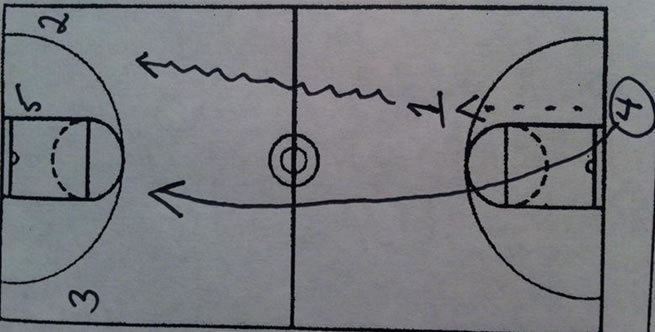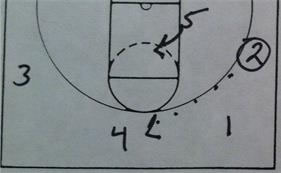|
The Carolina Break for Middle and High School Teams By: Danny Wilkerson Provided By - Stack.com
 Middle and high school basketball coaches who prefer an up-tempo style have several options when using the Carolina Break. The offense works well because you can run the options against either man-to-man or zone defenses. The Carolina Break, named for the quick style of play showcased by the University of North Carolina, is a secondary break with players "reading" the court to make the calls. With younger kids, the coach probably needs to call the options out to the players. Primary Break In our primary break, when two or fewer defenders are back, we try to get the ball up the floor as quickly as possible. If we are in a two-on-one situation, the only thing we want is a layup. Every player must recognize whether we are in a primary or secondary break. Our main drill for the primary break is a 3-0, 1-1, 2-1 drill. You should perform this drill daily. 3-Man Weave
During a game situation we want all five players to box out and crash the defensive boards. After we secure the rebound, the 2-guard and the 3 stay wide and run the right and left wings. The first post player down the floor looks to run rim to rim, or at least from the top of key to the top of the other key. When he or she gets to the top of the offensive key, he or she should find the ball and look to post up on that side. The other post player stays behind the ball in case of a turnover. The point guard (1) looks to get the ball up the floor as fast as possible, always trying to pitch it ahead to an open teammate. If the opponent makes a basket, we still look to run. Our 4 man is designated to take the ball out of bounds. The 4's first look is to throw it long to 2 or 3 running the lanes. We are not concerned with a long pass being thrown away or stolen, because if the opponents expect a long pass, they will sprint back on defense and forgo the chance to put any type of pressure up front. On the outlet, the 1 needs to get as deep as possible, come back to the ball and use an L-Cut or V-Cut to get open. When 1 gets the outlet, we teach him or her to catch the ball, put it on his or her hip (in triple threat position) and attack. This technique gets the 1 under control and reduces the chance for the defense to sneak in and take a charge. The 1's job now is to get the ball down the floor as quickly as possible and get under control. Any time there is an open man in front of the 1, he or she should pitch it ahead. We drill this each day. It's an error not to give the ball up to an open teammate in front of you.
Diagram 1: Alignment on a Made Basket Secondary Break The main job in the secondary break is to get the ball inside to the post. If you have really good shooters, give them the green light to shoot 3-pointers on the secondary break. We follow the rule that if I feed the post and he or she kicks it back out to me, then I've got the green light. Or if dribble penetration draws a second defender, and there's a kick-out pass, take the open 3-pointer. On a kick-out from the post or a drive, the shooters need to call "top" or "bottom" to let the passer know where they are. A good pass is necessary in this situation, because it will lead to a good shot. Hit the shooter in the hands. Option 1, Feed the post
Remember: Volleyball is a game of acceleration. Improve your first step speed mechanics and you will improve your entire game.
Diagram 2, Diagram 3a, Diagram 3b
Diagram 4, Diagram 5, Diagram 6
Diagram 7 Secondary Break Plays You can call these set plays out of the secondary break. Cross
Double
Clear Out
Gonzaga
Texas
Flex
Dive
Diagram 8, Diagram 9, Diagram 10
Diagram 11, Diagram 12, Diagram 13
Diagram 14, Diagram 15 When running the secondary break, we want to get the ball inside first. That opens up the outside shot. To play like this, your team has to be conditioned and must run on every possession. We want to negate the other team's pressure and score before it can set up on defense. The opposing defense is forced to give us something. It cannot pressure the perimeter and keep the ball out of the post at the same time. I wouldn't recommend trying to run every option—pick a couple that work for your team. This offense can work with all levels of players. Use a fewer number of options for younger players as they learn the offense and then add more plays as the players progress. |













